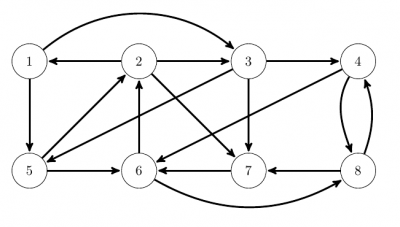Math 445 Lab 6: Google Page Rank
Part 1: Compute the Google Page Rank for a very small network of links.
(a) The following directed graph represents links between eight webpages:
Give the Page Rank of each page, and provide a list of the page indices sorted by their Page Ranks. You can refer to class notes or http://www.ams.org/samplings/feature-column/fcarc-pagerank for details of the Google Page Rank algorithm.
Hints
- It's good to have a firm grasp on the mathematics before writing the code.
- Write your code in a script file and run the script from within Matlab.
- Use
L = zeros(8,8)to allocate an 8 x 8 matrix of zeros, and then insert 1s at the required spots with statements likeL(3,4) = 1. - Better yet, store the set of nonzero indices as a
N x 2matrix in a filelinks.asc, then load that matrix into Matlab withload links.asc, and then loop over theNrows oflinksand assign ones into the specified elements ofLwithL(links(n,2), links(n,1)) = 1wherenis the loop index. - The transition matrix
Thas a1/neverywhereLhas a 1, wherenis the number of nonzero entries in the same column ofL. Instead of calculatingTyourself and typing it in, use Matlab to calculate it fromL. Hints:s = sum(L)will give you an 8d row vectorswhose elements are the sums of each of the eight columns ofL. Then thejth column ofTequals thejth column ofLdivided bys(n).
(b) Suppose that, instead of representing links between web pages, the directed graphs tell who likes whom among a your circle of friends, and that you use the same algorithm to compute a Likeability Rank, with the same numerical results. Would this give true quantitative values and rankings of how likeable your friends are? Why or why not? What does your answer here say about Google Page Rank as a method of ranking web pages?
I don't have a specific answer in mind here. Just be thoughtful and express yourself clearly.
Part 2: Compute the Google Page Rank for a network of 100 pages within www.unh.edu.
(a) Go to the website Numerical Computing with Matlab
by Clive Moler and download the “surfer.m” program. Set N=100 and run the command
[U,L] = surfer('http://www.unh.edu',N);. This might take a few minutes.
(b) After some time a vector U of websites will be generated and a matrix L of links will
be generated. All the entries of L should be either 0 or 1. But L will have 100^2 == 10,000 entries,
so you can't check this by eye. Write a short piece of Matlab code that double-checks that all entries of
L are either 0 or 1.
(c) Now generate a T matrix as described in problem 1. You will probably run into an error in
part 2, namely a webpage might contain no links or only links outside the set of pages we are working with.
In that case we will just assume that the person randomly selects a new website among all the N pages
in our set. Revise your calculation of T so that if a column of L sums to zero, then each of the
entries in the same column of T is 1/N.
(d) Suppose that instead of always clicking on a random link within a page, a web surfer sometimes
(with probability alpha) jumps to a random page chosen from all the pages in the network. We can
model this behavior by modifying the transition matrix T as follows
T = (1-alpha) T + alpha 1/N;
where 1 is a matrix of ones. Rumour has it that Google uses alpha = 0.15, so use that value
and calculate T.
(e) Double-check that the sum of each column of T is 1. Again, be clever and get Matlab to do
the work, rather than listing out the sums of all the columns and verifying manually that each of the
100 numbers is 1!
(f) Let’s assume we start at the first webpage, x=zeros(N,1); x(1)=1;. If we applying T
to x many times (say 1000 times), the resulting vector will give the probability that we end up
on a particular website and after a long session of random web surfing. We can do this the slow way
by using the code
m=1000; for j=1:m; x=T*x; end
or a faster equivalent way
m=1000; x=(T^m)*x;
After that is complete the values of x give the probabilities that a random web surfer will end
up at the web pages listed in U, and you can rank the pages in U according to their probabilities
in x. Look up the sort command in the Help menu and find a way to print the list of
websites in order of their rank. Turn in the list of the top 10, the fraction of the time a random
web surfer would spend in each one of those 10, and your code to complete the Lab. Note: There is
a faster way to compute the solution for very large matrices, but we will not worry about that here.
Our method would work fine until you reached the scale of 8,000-10,000 websites. Don't try it!
(g) If you are interested: Our calculation involved two free parameters: the probability alpha
of jumping to an entirely random page in the network, and m, the number that specifies the
length of our long session of random web surfing. How robust is the page rank algorithm with
respect to these two numbers? If you change alpha to 0.1 or 0.05, do the top 10 pages change?
How about if you change m to 10^4?

